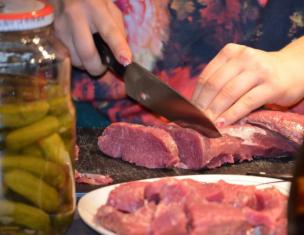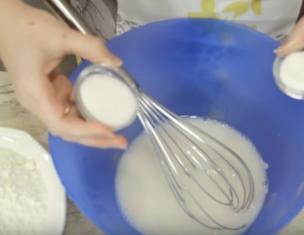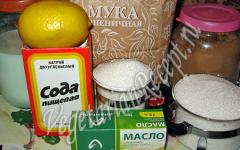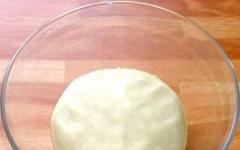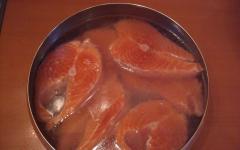Thanks to the invention of a tailor and the desire of a person to hide imperfections in appearance, the raglan sleeve was invented and created.
Raglan sleeves have the universal ability to shape your figure. The line of inclination of the raglan sleeve determines whether this sleeve will visually expand the line of the shoulders or, on the contrary, narrow them as much as possible.
Agree, for many women this is simply a “lifesaver”!
Today we’ll look at creating a raglan sleeve pattern in the simplest way...
The classic women's vest is an integral part of the wardrobe business woman. It looks great in an ensemble with a jacket, trousers or a skirt, the so-called three-piece suit. But you don’t have to wear a vest only this way; it also looks great in an urban casual style.

As a basis for modeling a classic women's vest, we take the basic pattern that we receive.

Shelf modeling:

1. Draw a line from the neckline to the protruding point of the chest
2. Cut this line, close the chest dart and eliminate the waist dart. From the center of the neckline, draw a line for the top cut of the dress, forming a right angle at the top of the new armhole, connecting it to the bottom of the armhole. The height of the bodice is adjustable according to your wishes
3. Draw the direction lines of the proposed folds
4. Cut along the lines of the folds and spread them to the desired fold sizes...
 Modeling with one-piece short sleeve:
Modeling with one-piece short sleeve:
Many needlewomen believe that only a sewing guru can do it with their own hands. "Nothing like this!" - I will answer you. Today we will look at the cut of the coat that Kate Middleton herself sported! After Kate came out wearing this coat, Max Mara named the model of this coat in her honor. 

A young brand working on creating a collection does not always have the opportunity to turn to a professional designer. We found out what programs for designing, modeling and laying out patterns are used in production, and also tried to find several services with simple functionality that are suitable for home use.
A computer-aided design system, abbreviated as CAD, is a general classification for all design programs. Their basic functions are largely similar; their appearance, additional options and cost differ. The price, as a rule, depends on the set of blocks or additional modules, and can also change with the advent of updates.
CAD GRAFIS
Grafis is a development by Cadrus, which specializes in software products for sewing production. The program has an accessible navigation system, and also has the ability to integrate previously developed paper patterns. Grafis CAD includes options for product bases: skirts, trousers, men's and women's shoulder bases, knitted bases, children's bases, underwear bases, denim bases, workwear bases and hats. The program can perform automatic gradation based on size characteristics, set allowances for products and do manual or automatic layout of cut parts.
For potential clients, Grafis developers hold free seminars where they talk about new products in the field of CAD and modern methods creating collections of sewing products. At the end of each seminar, a trial lesson is held, during which participants can model a simple product, make gradations of patterns and print them. On the website you can apply for a free pilot implementation of the program to learn more about all its functions. There is no publicly available information about the cost of the program.
CAD Julivi
The Saprlegprom company offers several software solutions for sewing production. The company's Julivi system includes 2D and 3D clothing design programs.
The “Design” program can build basic structures from scratch using any method (Muller, EMKO SEV, etc.) in one or more sizes. List of features in basic configuration includes the creation of a design drawing, increasing allowances and designing cuts, automatic gradation, as well as the ability to develop a design for an individual figure. The basic package of the program costs 450 euros. In addition to the main block, you can connect modeling functions, measurement databases, a set of ready-made basic and model structures, and some other modules. Their cost varies from 400 to 500 euros.
Another set of programs, “Constructor”, is suitable for creating patterns for clothes, shoes, hats, and upholstered furniture in the sewing industry. Allows you to work from a basic or standard design to launch into production, reproduces patterns, models, builds linings and adhesives. The program is adapted for designing products from textiles, knitwear, leather, and fur. The basic module will cost 950 euros, additions to it will cost from 200 to 1950 euros.
The Julivi system also includes the programs “3D mannequin”, “Layout”, “Plotter control”, “Table of measures”. The website contains detailed video tutorials on using the services and there is an opportunity to work with the demo version online.
CAD Grace
CAD Grace - these are several kits designed for different types production. The “Enterprise Kit” consists of design, construction and modeling systems and pattern layout. Builds layouts of cut parts that are optimal for saving materials, and also calculates cutting according to material layers. This is the most expensive modification of the program, its cost is 350,000 rubles. In addition to it, there are versions “Set for Studio”, “Set for Freelancers” and “Set for Students”. Each of the kits can be purchased or rented for one year - then the price will be significantly lower. For example, the “Set for Freelancers” can be purchased for 125,000 rubles, and rented for 25,000 rubles.
Trial versions of services can also be downloaded on the website and used for one to two months, depending on the package. There you can also watch presentations, video tutorials and examples of constructing men's and women's clothing.
CAD Leko
The developer of Leko, the Vilar company, offers three versions software. The shortened version is suitable for small organizations or young brands. This version includes an installation disk with the program, a description, a design book and a database of designs and methods, as well as standard and individual dimensional characteristics (OST, GOST and the ability to calculate arbitrary sizes). You can create a grid based on several sizes and heights, build manual lines and gradations, and lay out a set of patterns for printing.
The cost of the shortened version of “Leko” is 70,000 rubles. A more complete version forms seam allowances and marks patterns; its price is 100,000 rubles. IN latest version, which will cost 170,000 rubles, there is the possibility of laying out several sets of patterns and a database of layouts.
RedCafe
The Redcafe clothing editor allows you to work with drawings at the level of lines, points and objects, build and model clothing patterns. The program can set seam allowances, make gradations and spread patterns. Patterns can be scaled, changed, moved. The program also allows you to digitize paper patterns, patterns from books and magazines. Redcafe includes base standard sizes with the ability to add custom ones. This editor has two paid versions. The first costs 19,950 rubles and includes the entire set of necessary functions. The second version is supplemented with a database of professional patterns for production and ateliers, its price is 29,950 rubles. A free version of the program is also available for download on the website, but printing patterns when using this version will be paid.
The website has detailed video tutorials and a description of the program's functionality, and the blog contains examples of patterns, master classes on designing, modeling and sewing women's, men's and children's clothing.
FanReal
A free program for constructing the basics of patterns for individual women's clothing: shoulder items (dresses, jackets, demi-season coats), as well as skirts and trousers of various styles. FanReal allows you to display the created pattern as a sketch and select the color of the product. Patterns can be made for any type of figure, including individual sizes. In the program you can select a style, set allowances for freedom of fit, change and clarify dimensional data when constructing. The developer warns that this pattern-making system is being finalized, so just in case, he suggests measuring all patterns after printing.
Cameo
The American company Wild Ginger Software specializes in developing software and related products for clothing designers, sewing and craft enthusiasts, as well as for teachers and students in the field of fashion design and theatrical costume. There are two programs available on the site - Cameo and PatternMaster, each with its own set of blocks that can be purchased separately. There are demo versions to familiarize yourself with the main functions.
The professional design program Cameo consists of three blocks, which include the capabilities of constructing, modeling and grading patterns. Each block costs $950. In addition to Cameo, the developers offer to purchase sets of patterns for women's, men's, children's clothing, knitwear and underwear.
Also on the site you can purchase books on design and modeling, patterns for women's clothing and download a program in which it will be convenient for the designer to store photos of samples and information about the fabric. You can evaluate this program by downloading the demo version.
PatternViewer
PatternViewer ‒ free program American developers PatternMaker, which contains built-in templates for women's clothing models. The program allows you to use both basic sizes and set individual parameters. The number of models in this version is limited, but additional units with an expanded range of capabilities can be purchased on the website. Thus, the Deluxe Editor block includes a more complete database of templates and makes it possible to model products based on them. ProfessionalStudio has all the basic functions of a professional design system: independent creation of patterns, marking of allowances, marking of parts.
Each of the blocks can be tried for 30 days free of charge, in the future the price will depend on the level and volume of production. Free version and the program for $99 can be purchased by those who sew at an amateur level. For designers, a more complete package of functions will cost $399, the same package, but with the ability to graduate patterns, will cost $1,199. A full set of program modules for sewing production will cost $2,499.
from Nadezhda AzarovaEach of us, deep down in our souls, knows perfectly well what Yanina Ipokhorskaya expressed in one phrase - "Wearing one dress for too long is harmful to the body". This is why we are so sensitive to fashion changes and crave new outfits so much. Our eyes are always open to searching for something new. We immediately understand where the new fashion is and where the old one is. Remember "Gone with the Wind", when Scarlett O'Hara, after experiencing shocks, meets with a former manager. He arrived in a new carriage, and with him was a stranger dressed in latest fashion. Scarlett quickly appreciated the details of the fashionista's outfit: skirts were not so wide, and jackets became shorter. The features of the new fashion have been defined - you can start cutting a fashionable dress from your mother’s velvet curtains!
What Scarlet did is called “breaking down the style into design elements.” And what she then planned to do with the curtains is called “modeling on fabric.”
In this course we will study basic modeling techniques, which designers have developed since ancient times.
For some reason, many people believe that there is a separate modeling for skirts, and there is a modeling for trousers. And this is understandable. When you want to sew something specific: a dress, blouse or trousers, you start looking for modeling of this particular group of products. Moreover, if you need an evening dress, then you start looking for modeling evening dresses. Is it true?
Book producers are shamelessly speculating on this peculiarity of ours.
And they publish the corresponding publications “Modeling blouses for work”, “Modeling trousers for leisure”, etc. However, my friends, even if they sell you 7 multi-colored panties a la “week”, they are still just panties. From the designer's point of view, they are absolutely identical underpants!
I want you to not buy another mind-bending book on modeling for Monday or modeling for Friday. I want you to learn how to model any product any day of the week!
This is shocking. But believe me, there is no special modeling!
There are simply a set of techniques that you can apply to any product and any pattern.
You know, if you know how to cook soup, then it doesn’t matter what or where. You can cook soup on the stove at home or in a pot while camping. It's the same with modeling. If you took the trouser base, you will model the trousers on it.
If you took the base of the dress, you will receive a new dress. The basics of the products are different, but the modeling techniques are the same!
When I tried to convey this idea to one of the students, she stubbornly repeated to me that the dresses were different. Like, an evening dress is one thing, but a dress for the house is another. Don't believe it. Don't go to those who tell you this. They lie shamelessly. There is a dress pattern and there is the fabric from which it is made. It is the fabric that determines the perception of the dress. Cotton is one dress, and embroidered satin with lace is another. In this course we will learn how to model any dress! And any pants.
And even any skirt. I really want you to be able to model anything by the end of this course. From photographs, from sketches, from a dress seen out of the corner of my eye in a shop window. I remember how I once took courses myself. It was a long time ago, back in school. We spent two years building something in notebooks. Either this kind of blouse or that.. We have collected basic modeling lessons for you so that, firstly, you can learn them, and secondly, so that they are always at your fingertips.
The basis for modeling is . If you have a ready-made pattern for the base of the dress, you can use it or create a pattern for the base of the dress according to your own measurements.
Modeling Lesson #1: Increase Determines Silhouette
We have already repeatedly explained how important it is to correctly increase the freedom of fit. It is the increases that determine the silhouette of the product.
In this regard, we derive a simple rule: one base pattern - one dress silhouette.
If you want to sew a fitted dress according to your figure, you need a base pattern with a fitted silhouette, for a straight silhouette you need your own base pattern, for a loose one - your own. Therefore, before creating a pattern for the base of a dress or jacket, think and decide what silhouette you want and what additions you will make.
You can find more information on increases in the section “How to sew clothes to fit your figure.”

After the base pattern is constructed, we move on to modeling.
Modeling lesson No. 2: transferring the bust dart
There is only one chest dart, but there are so many options. And these are just the basics ready-made solutions. Use your imagination, because once you understand the basic principles of modeling, you can create real exclusive clothing models!

I said that many clothing models do not have significant differences in the design of the main parts and differ from each other precisely in their model features. That's why a large number of models can be represented by a limited number of basic clothing designs, modeling basic patterns.
Clothes modeling- this is a transformation of the basic design of a product in order to change its model characteristics.
There are several types of transformation of the basic structure:
1) without changing the shape of the product
2) change in silhouette, without changing the volumetric shape in the area of support areas
3) complete change in volumetric shape
4) changing the cut of the sleeve
5) obtaining new clothing models complex shapes and hybrid designs
Let's take a closer look at structural transformations and basic modeling techniques.
Modeling techniques of the first type
Modeling the basic design without changing the shape of the structure itself includes: transferring darts in different directions, transferring division lines, combining parts (excluding seams) or additionally dividing them into smaller parts, designing folds, developing model features of a collar, lapel, side, pockets, small parts, loops, buttons.Modeling method: transfer of darts
Dart- this is a constructive technique with the help of which a three-dimensional shape of the product and a uniform fit are achieved flat material complex body configuration.The chest dart is always directed towards the center of the chest and can be moved to the armhole, side cut, mid-front line, waist, or neckline.

Any dart can be replaced with tucks or gathers.

To move the chest dart, mark its new position, then cut the pattern along this line and, having closed (layed) the main dart, open it in a new place. To achieve smoothness when processing a bulge on the chest, the dart should not reach the center of the chest by 1-2cm.
For shoulder back darts, a technique is often used to transfer the darts into several equal ones, the solutions of which are not ground off, but ironed, creating the necessary convexity in the area of the shoulder blades.

Modeling method: additional structural divisions
The division of clothing parts into parts is important for its formation. The optimal position from the point of view of the conditions for the formation of the required shape is occupied by horizontal and vertical divisions. The main vertical form-building elements are: side cuts, reliefs, darts, middle cut of the back. The main horizontal form-building elements are: yokes, set-in belts, horizontal undercuts.
In some clothing models, darts are often absent as an independent design element. Instead, decorative and structural seams (reliefs) and division of the main structural parts are used to create a three-dimensional shape of the product. That is, the translation of darts can be achieved by the method of additional division of parts.
When modeling yokes and reliefs, the dart is transferred into a relief seam or a yoke seam, and if the seam passes through the support areas, the dart is completely transferred into it.
Supporting surfaces of clothing- these are areas of contact between clothing and the human body. For shoulder clothing - this is the neckline, armhole, protruding points of the shoulder blades and chest. For waist products - the waistline, upper thighs and abdomen.

![]()


If the seam does not pass through the supporting areas, then part of the dart is retained.

To perform modeling, a cutting line is applied to the part, which may not reach the ends of the darts. The undercut line is connected to the end of the dart by one or more lines. The part is cut along the marked lines and moved to the required size, closing the old position of the dart. If the resulting solution does not provide the required size for gathering, folds or drapery, apply additional spreading lines from the undercut, cut along them and spread the part, achieving the required shape. In this case, the allowance for creating a small overlap (0.5 - 2.0 cm) is taken into account; without this, defects in the fit of the product may occur.

Modeling method: development of decorative elements of the main components of the product
Sewing product unit- this is a complex connection of parts, individual parts of a part (for example, a collar assembly, a pocket assembly, etc.)This stage includes the design of edge and lapel sections, determining the locations of loops, pockets, patches, buttons, etc. I will consider the development of decorative elements in more detail in practice in the following articles, but for clarity, in the figure you can see several options for modeling decorative elements .


Modeling techniques of the second type
Modeling of the basic design with a change in silhouette, but without changing the shape of the volume in the area of supporting areas includes: moving the waist line, increasing or decreasing the fit along the waist line, expanding or narrowing the product downwards, etc. Transformation of the base pattern is achieved by the techniques of parallel expansion or conical expansion .Simulation method: parallel expansion
Parallel expansion is used to design soft gathers or folds on product parts. To do this, the location of the folds is marked on the part, then the part is cut into parts in accordance with the drawn lines and moved apart to the required amount. Depending on the model of clothing, the expansion of parts may be uniform or uneven. The expanded part is obtained by moving the part step by step and tracing the outer contours of the strips. The final contours of the transformed sections of the part are designed with pattern curves: assemblies - with a smooth curve; folds, tucks - broken straight lines.

Modeling method: conical expansion
The conical expansion of clothing parts, depending on the designed model, can begin at any level: shoulder line, chest, waist, hips, knees and below. Determination of the level of expansion and the amount of expansion are determined by appearance product or drawing, first tentatively, and then when trying the product on the figure - finally. Conical expansion is often used in combination with parallel expansion.

When modeling folds in complex draperies, it is recommended to use the dummy method.

Modeling techniques of the third type
Changes in the volumetric shape of the basic design include: an increase or decrease in volume along the chest line; changing the width of the back and shelf; shoulder enhancement (introduction or change in the thickness of shoulder pads); lengthening or shortening of the shoulder, the nature of its design; changing the depth of the armhole, its design. Changes in the volume and shape of the product in the shoulder area and along the chest line are often accompanied by additional structural divisions and remodeling of the basic darts.Modeling method: dart demodeling
As the volume of the product increases, the nature of its supporting surface changes. Increasing the gaps between the figure and clothing on the chest line, as well as the introduction of shoulder pads, leads to a greater, in comparison with the basic, distance of the lateral sections of the back and front from the surface of the figure, that is, on the back in the area of the shoulder blades and in front at the level of the chest line, it decreases surface curvature. Structurally, this model form is achieved by reducing the openings of the upper front dart and the shoulder dart of the back, up to their complete elimination by remodeling the base darts.
Under dart demodeling understand the translation of any part of it into sections (armholes, necklines, bottoms, etc.) in order to lengthen them, which allows you to obtain a flatter shape that does not emphasize the shape of the body.

Armhole modeling
The armhole is a functionally important component of a shoulder product with a set-in sleeve. Its parameters and configuration are determined by: the designed shape of the back and front parts, the share of the total increase along the chest line coming to the armhole section, the design of the shoulder sections, the model width of the sleeve at the top, technological requirements, etc. Various combinations of these factors determine many options for model armholes.

Modeling techniques of the fourth type
Changing the cut of the sleeve involves combining the details of the set-in sleeve of the basic design with the details of the back and front for their subsequent division with new model lines. The most typical examples of modeling a basic set-in sleeve design are conversions to designs with raglan sleeves, one-piece, shirting and combinations using basic clothing designs with set-in sleeves.

Modeling techniques of the fifth type
Complex transformations of the design of one type of clothing into the design of another type are carried out using standard designs of the closest type. Examples of obtaining new types of clothing based on standard ones are capes, capes, overalls, trouser skirts, shorts, swimming trunks, etc.
In conclusion, I would like to add that in practice, several modeling methods can be used in one product. I will consider in more detail how to implement these methods in the following articles.



